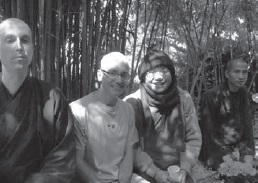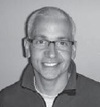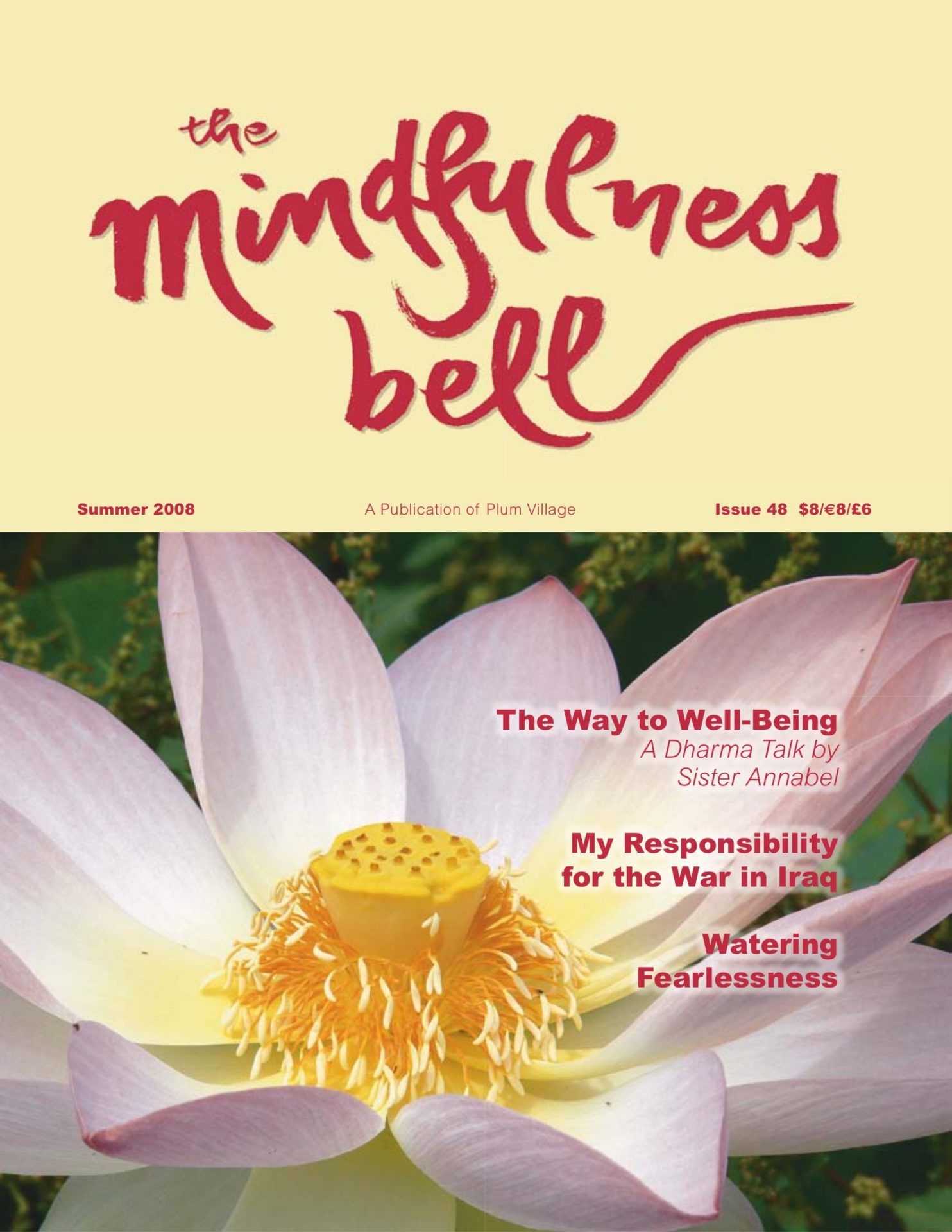
By Laurie Arron
“I believe that we all have the need to love and to be loved, and life without love is not pleasant, it is suffering.” —Thich Nhat Hanh, Friday, July 13, 2007, Lower Hamlet
These are the words Thay spoke to me during the first Question and Answer session of the summer retreat at Plum Village. I had asked about finding love and had clearly stated I was gay.

By Laurie Arron
“I believe that we all have the need to love and to be loved, and life without love is not pleasant, it is suffering.” —Thich Nhat Hanh, Friday, July 13, 2007, Lower Hamlet
These are the words Thay spoke to me during the first Question and Answer session of the summer retreat at Plum Village. I had asked about finding love and had clearly stated I was gay. Thay’s answer was all about true love, and it demonstrated to me that he believes true love is possible regardless of sexual orientation.
Although I’ve accepted being gay, there’s still a voice in my head saying there’s something wrong with me. I’m forty-five now, I’ve been single for over four years, and I don’t know if I’ll ever find true love — or be able to let go of my grasping for it.
Years of Silent Suffering
Sometimes the memories of being a gay teen cause tears to well up inside me. I know that I have a long way to go in healing my suffering.
I first realized I was gay when I was thirteen years old. It was a terrible and frightening realization. At school, a “fag” was the worst thing you could call someone. It’s what we called the kids we didn’t like, the ones who didn’t fit in. I’d used it many times. How could I possibly be one of them?
But the fact was that I had a strong physical attraction to some of the boys in my class and none whatsoever towards the girls. My grim realization was indisputable.
I could not deny my sexual orientation, but I could keep it an absolute secret. I thought being gay was unnatural and I desperately wished I could be “cured.” I was convinced if anyone knew they would hate me, except my parents who would simply be devastated. I thought it would be better to be blind or in a wheelchair. At least then people wouldn’t hate me.
I hid my sexual orientation from everyone until I was twenty-seven years old. Being “in the closet” was very difficult, and I turned to smoking marijuana to ease the pain and escape my reality. I did fine in school and work, but whenever I thought about having to live life without love I was consumed with despair. It wasn’t until a close friend of mine (who wasn’t gay) killed himself that I realized life was too short to waste. I decided to take a leap of faith and stop hiding who and what I really was.
I went to a “coming out” support group and there I finally started to accept my sexual orientation. At the group they did things like turn on their head the questions gay people often get asked. They pointed to the absurdity of asking questions like “when did you first realize you were heterosexual?”, “what do you think your parents may have done to contribute to your heterosexuality?” and “what made you choose to be heterosexual?”
I’ve come a long way since then. I got involved in working for equality for lesbian, gay, bisexual and transgender (LGBT) people when I was thirty-one and eventually became Director of Advocacy for Canada’s national LGBT equality advocacy group. In 2005, Canada’s federal government debated and passed a law extending civil marriage to include same-gender couples. I did many media interviews and was about as publicly “out” as you can be.
But even being so comfortable with being gay, in public places I still had to ask myself whether it was safe enough to hold my partner’s hand or give him a kiss when I greeted him at the airport after not seeing him for several weeks. These are simple acts that most people take for granted, but for gay and lesbian people they are not so simple. And that’s in Canada, one of the most accepting and progressive countries in the world. In many countries, being gay is still criminal, sometimes even punishable by death.
I look back and sometimes it feels like my youth was stolen from me. While my friends learned to date and to be in relationships when they were teenagers, I started from scratch at age twenty-seven. The whole possibility of young love was already gone.
I find it particularly hard not to regret those lost years and wish I’d had more courage and come out earlier. My equality advocacy has been driven by my desire to make the world a better place for LGBT youth, so they don’t have to go through what I did.
The most difficult thing about the suffering I experienced was not being able to tell anyone. I suffered alone and in silence, with absolutely no support. I think about how wonderful it is to have a Sangha for support. Looking back on my years in the closet I realize that it was the exact opposite. The fact of not being able to tell anyone magnified my suffering a thousand times.
The Question of Marriage
A big source of suffering for LGBT people is the exclusion from marriage. It’s often said that love and marriage go together, but for same-gender couples this is usually not permitted. Only the Netherlands, Belgium, Spain, Canada, and South Africa have equal marriage. The Commonwealth of Massachusetts permits same-gender couples to marry but our marriages are not recognized by the federal government. Israel also recognizes our marriages, but they must be performed in another country.
Marriage is about many things, including love, commitment, intimacy, companionship, emotional support, financial support, children, and fidelity.
Some people argue that marriage is essentially about procreation, but many opposite-gender couples don’t have children and many same-gender couples do. According to the Canadian Psychological Association, studies show that children of same-gender couples do just as well as other children and are no more likely to be gay or lesbian themselves.
Simply put, marriage is the central and most prominent way in which society recognizes romantic love and commitment. Since being gay is defined by who you love, the exclusion or inclusion in marriage sends a powerful signal about our place in society.
Exclusion says our love is inferior to the love between a man and a woman. This message does us great harm, both in affirming anti-gay attitudes and also in telling LGBT people that there’s something wrong with us. Inclusion in marriage sends the message that we are not flawed because of our sexual orientation. It says that we are equally worthy of respect and consideration.
This is especially important for LGBT youth. This poignant letter to the editor was written when equal marriage legislation was before Canada’s Parliament:
“I wonder if those fighting so hard against same-sex marriage ever consider how much it means to gays. They don’t know what it’s like to be a teenager — when the pressure to conform is so great — and you experience the horror of realizing that you are gay. They can’t understand what it’s like to listen to your friends talk about how they hate queers and how they wish they were dead. You consider suicide, because you never want anyone to find out the truth about yourself; your shame is too great to bear.
“And these people can’t understand the hope that filled my soul when I first found out that Canada was considering allowing same-sex marriage. This legislation goes so far beyond marriage. It is a symbol. It represents the hopes and dreams of gays for a better world. Now that I’m 18, I can finally admit to myself that I am gay and no longer feel the shame that almost drew me to suicide. At least now I have hope.”
The Desire for True Love
My deepest aspiration is to understand my suffering and to transform it. At Plum Village Thay Phap An told me that most of us spend much of our time struggling with one particular issue, one that is based on a misperception of reality. This misperception acts like a prism, distorting how we see the world and causing us to suffer. Covering up this misperception is a block of pain that has been built up over the years.
My block of pain seems to revolve around my desire to find true love and my belief that I won’t, perhaps because there is something wrong with me, or perhaps because I am simply fated to be alone.
I have had many insights about the source of my suffering, usually when I cry during sitting meditation. This has happened many times when I recall a feeling from the past, such as the sadness and despair when my partner left me, or the fear that I will never find another. And then another thought will manifest, perhaps from a different time in my life, and I know that there is a connection between the two.
Slowly, slowly, I am chipping away at the block of pain that exists deep inside me. I still have a long way to go to get through the block of pain, and to see and penetrate the misperception that lies beneath it. I don’t know if I will ever get there, but I know I am on the path, and I have faith in that path. The more diligent my practice, the happier I am.
For example, sometimes I despair. But I identify it as despair, or perhaps a mix of despair, sadness and grasping, or whatever feelings I can identify. I observe my in-breath and out-breath. I remind myself that this is just a feeling, and that feelings come and go.
For much of my life I learned to suppress my feelings and to cut myself off from my body. But that did not end my suffering. If anything, it made the suffering worse and prevented me from taking positive action. My practice is helping me to re-connect with my body and to become whole again.
Feelings are not only in my mind, but also in my body. I find the feeling in my body and I describe it to myself. Perhaps the feeling is a tension between my shoulder blades, or tension from my neck extending outwards to each arm. I observe that this is how despair is manifesting in my body. When I release the tension in my body, the feeling also dissipates. Sometimes this happens quickly, sometimes it takes a long time. Sometimes I don’t have time to wait because I’m too busy at work and I just live with the tension until later.
Underneath despair I find joy. I have experienced this hidden joy many times. Sometimes I can even find joy without having to go through despair. If I just look around my body, I can almost always find somewhere that’s experiencing joy.
Smiling Through Tears
I have also observed that I need my Sangha to support my practice. It is so easy to practice at Plum Village, but so difficult to practice in the world, with the pressure of work, friends and the dominant western culture. My Sangha helps motivate me to be diligent.
My practice helps me transform my suffering into happiness. It gives me faith that there is a way out of suffering. It reminds me that my suffering is impermanent. With this awareness, I can smile through my tears.

Laurie Arron, Faithful Embrace of the Heart, is an aspirant to the Order of Interbeing. He divides his time between Toronto and Ottawa and is a member of the Mindfulness Practice Centre of the University of Toronto and the Pine Gate Sangha.

